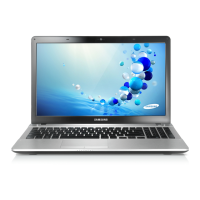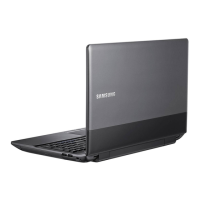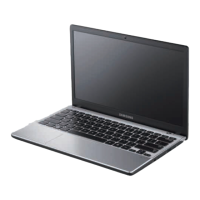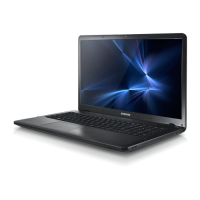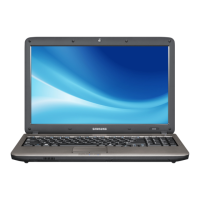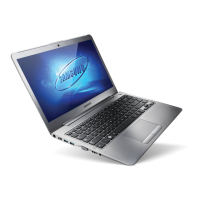Do you have a question about the Samsung NP300E5C and is the answer not in the manual?
Information to check before reading the manual, covering structure and image usage.
Steps for troubleshooting and contacting the service center for computer issues.
Guidelines to prevent injury/damage during computer use (installation, power, battery).
Guidance on correct posture for comfortable, safe computer use and preventing strain injuries.
Identification of computer parts via diagrams of front, top, and side views.
Instructions for powering the computer on/off and adjusting screen brightness.
Overview of Windows 8 as the OS and how to use its help features.
Explanation of Start screen and Desktop modes in Windows 8 for navigation.
Details on the Charms menu functions (Search, Share, Start, Devices, Settings) and activation.
Instructions on launching, closing, and managing apps, including multitasking.
List of hotkeys and their functions for efficient Windows 8 operation.
Explanation of keyboard hotkeys for controlling computer features.
Guide to using the touchpad for cursor control, clicking, dragging, and gestures.
Instructions for inserting, playing, and ejecting CDs/DVDs.
Guide to inserting, removing, and using memory cards (SD, etc.).
How to connect external monitors or projectors via D-SUB or HDMI.
Methods for adjusting system volume via keyboard or software, and using the microphone.
How to adjust screen brightness for viewing and battery saving.
Steps to connect to a wired network and configure IP settings.
Guide to connecting to Wi-Fi and troubleshooting connection issues.
Introduction to built-in multimedia apps like S Camera, S Gallery, and S Player.
How to use SW Update to install software and driver updates from Samsung.
Using Support Center to diagnose computer issues and find solutions.
How to use the Kensington lock slot to secure the computer.
Introduction to BIOS setup for system configuration and its purpose.
How to set passwords for system boot and BIOS access for security.
Instructions to modify the boot sequence for prioritizing devices like hard drives or USB.
Step-by-step guide for installing or replacing the computer's RAM modules.
Information on battery charging, usage, and maintenance to extend battery life.
Procedures for backing up data and restoring the computer to a previous state or factory settings.
Steps for reinstalling Windows 8 using recovery media, including custom installation.
Answers to common user questions regarding Windows 8, hardware, and software.
Detailed technical specifications of the computer, including CPU, memory, storage, and graphics.
Guidelines for environmentally responsible disposal of electronic products.
Definitions of technical terms and jargon used in the manual.
Information on international warranty terms, conditions, and coverage for Samsung products.
Contact information for Samsung service centers and official websites for support.
| Bus type | DMI |
|---|---|
| Stepping | L1 |
| Tjunction | 105 °C |
| Processor cache | 3 MB |
| Processor cores | 2 |
| Processor model | i5-3210M |
| System bus rate | 5 GT/s |
| Processor family | Intel® Core™ i5 |
| Processor series | Intel Core i5-3200 Mobile series |
| Processor socket | BGA 1023 |
| Processor threads | 4 |
| Processor codename | Ivy Bridge |
| Processor frequency | 2.5 GHz |
| Processor cache type | Smart Cache |
| Processor lithography | 22 nm |
| Processor manufacturer | Intel |
| Processor front side bus | - MHz |
| PCI Express slots version | 3.0 |
| Processor boost frequency | 3.1 GHz |
| Processor operating modes | 64-bit |
| ECC supported by processor | No |
| PCI Express configurations | 1x16, 2x8, 1x8+2x4 |
| Thermal Design Power (TDP) | 35 W |
| CPU multiplier (bus/core ratio) | 25 |
| Maximum number of PCI Express lanes | 16 |
| Memory slots | 2x SO-DIMM |
| Internal memory | 4 GB |
| Memory clock speed | 1600 MHz |
| Internal memory type | DDR3-SDRAM |
| Maximum internal memory | - GB |
| Memory layout (slots x size) | 1 x 4 GB |
| HDD speed | 5400 RPM |
| HDD interface | SATA II |
| Storage media | HDD |
| Optical drive type | DVD Super Multi DL |
| Card reader integrated | Yes |
| Total storage capacity | 500 GB |
| Compatible memory cards | SD, SDHC, SDXC |
| Number of HDDs installed | 1 |
| Display diagonal | 15.6 \ |
| Display resolution | 1366 x 768 pixels |
| Native aspect ratio | 16:9 |
| Type | PC |
| LightScribe | - |
| Graphics card family | NVIDIA |
| On-board graphics card ID | 0x166 |
| Discrete graphics card model | NVIDIA® GeForce® GT 620M |
| On-board graphics card model | Intel® HD Graphics 4000 |
| Discrete graphics memory type | GDDR3 |
| On-board graphics card family | Intel® HD Graphics |
| On-board graphics card base frequency | 650 MHz |
| On-board graphics card dynamic frequency (max) | 1100 MHz |
| Speaker power | 1.5 W |
| WWAN | Not installed |
| Wi-Fi standards | 802.11b, 802.11g, Wi-Fi 4 (802.11n) |
| Bluetooth version | 4.0 |
| Cabling technology | 10/100/1000Base-T(X) |
| Top Wi-Fi standard | Wi-Fi 4 (802.11n) |
| Networking features | Gigabit Ethernet, WLAN |
| Ethernet LAN data rates | 10, 100, 1000 Mbit/s |
| Charging port type | DC-in jack |
| USB 2.0 ports quantity | 3 |
| USB 3.2 Gen 1 (3.1 Gen 1) Type-A ports quantity | 0 |
| Pointing device | Touchpad |
| Keyboard number of keys | 103 |
| Trial software | Norton Internet Security (60-day trial) |
| Bundled software | Easy Partition Manager Adobe Acrobat Reader Microsoft Office Starter 2010 WildTangent Game Console Windows Live Norton Online Backup Skype Cyberlink Media Suite Easy Migration Easy Settings |
| Operating system installed | Windows 7 Home Premium |
| Product color | Black, Silver |
| Battery capacity | 48 Wh |
| Battery life (max) | - h |
| Number of battery cells | 6 |
| Password protection type | BIOS, HDD |
| Processor code | SR0N0 |
| Processor ARK ID | 65708 |
| Processor package size | 31.0 x 24.0 (BGA1023) mm |
| Supported instruction sets | AVX |
| Intel Identity Protection Technology version | 1.00 |
| Motherboard chipset | Intel® HM75 Express |
| Depth | 243 mm |
|---|---|
| Width | 367.9 mm |
| Weight | 2300 g |
| Height (rear) | 34.9 mm |
| Height (front) | 29 mm |
